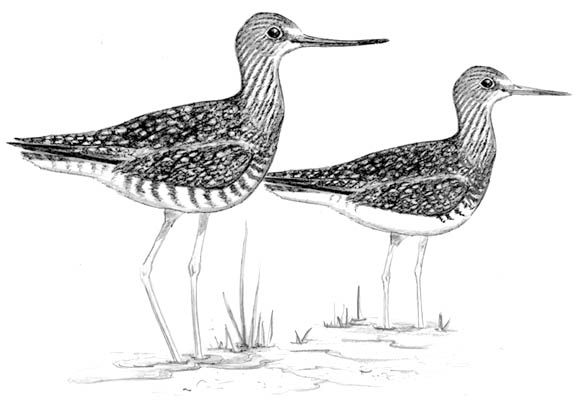
Dear Bird Folks,
I have been a bird watcher for many years but am not so sure if I have ever seen a Lesser Yellowlegs. I realize they are a little bit smaller than the Greater Yellowlegs, but without seeing them side-by-side I don’t think I would know which was which. Except for the size difference, how can I tell them apart? Also, do we even have Lesser Yellowlegs here on the Cape?
– Tom, West Hyannisport, MA
It’s confusing, Tom,
Trying to differentiate between Lesser and Greater Yellowlegs can be very confusing, but not nearly as confusing as trying to figure out why the “Hyannisport” part of West Hyannisport is one word, while regular old Hyannis Port is two words. Whose idea was that? Are the people in Hyannis Port too snobby to let the tiny community to the west of them use their name without making them change it a little? Or was it one of those naming rights issues, like what the jerks from Major League Baseball pulled on the Cape League baseball teams? The more important question is: Why do I even know about the two different spellings in the first place? I mean, who notices this stuff? I saw the dissimilar spellings one day when I was reading the zip code page in the back of the telephone book. Have you ever done that? It’s fun. Well, it’s fun once you get past the ad on the back cover for that creepy lawyer. What’s with that guy?
In order to avoid confusion I should explain to any non-birders out there what exactly yellowlegs are and what they are not. They are not tall people with jaundice or someone with a cheap spray-on tan. They are sandpipers, rather large sandpipers, also known as shorebirds. And yes, to answer part of your question, Cape Cod annually sees loads of both Greater and Lesser Yellowlegs. Beginning in July, their “fall” migration brings hundreds of these birds to the Cape’s mudflats and tidal pools. If you see a flock of feeding shorebirds with long, bright yellow legs, you can be pretty sure those birds are yellowlegs. That’s the good news. The bad news is that both species of yellowlegs have similar looking plumages. The other bad news for you, Tom, is that you want me to tell you how to identify Lesser Yellowlegs from Greater Yellowlegs without talking about the “size difference.” Sorry, dude, there is no other way. Size is the key. It’s just the way it is, but maybe this weird analogy will help you.
A good friend of mine has four sons who are about two years apart. She apparently liked the way the first child looked because each of her next three kids came out looking identical to the first. She thought it was cute but I thought it was kind of scary. Her family looks like a quartet of walking Russian dolls. (You know, those dolls where you open one up only to find a smaller but identical doll hiding inside the first.) The reason I’m mentioning this is because even if the kids are dressed alike I never have any trouble telling who is who. Because of their dissimilar ages each child is a different height and size. This same thing applies to Greater and Lesser Yellowlegs. Even though the birds are dressed alike (similar plumages), their different heights and sizes set them apart. (If you thought that analogy was weird it’s about to get worse.)
Lesser Yellowlegs look like the baby brothers of the Greater Yellowlegs. They are several inches shorter, have trimmer bodies and much shorter bills. The lessers look like middle school students while the greaters have the appearance of college kids seeking to join a frat house. But instead of growing long hair or beards, Greater Yellowlegs (for the sake of this analogy) let their bills grow too long. The bills on these birds are much longer than the bills of the smaller yellowlegs. Their bills are so long they tend to curve up at the end, which gives them a Bob Hope profile.
If none of this Russian doll/college student/Bob Hope talk is of any help to you, here are a few other clues to look for. Greater Yellowlegs are more assertive and aggressive in their actions and feeding behavior and often run in pursuit of their prey. Lesser Yellowlegs do more poking and are less energetic in their search of food than their larger cousins. The last identification key has to do with the voices of the two birds. As you might imagine the larger Greater Yellowlegs have a loud, startling voice. Whenever they are upset about something they give off a piercing three-note “dew, dew, dew” call, which informs the entire town they aren’t happy. On the other hand, the smaller Lesser Yellowlegs have a more passive, almost questioning two-note “tu-tu?” call. Their tu-tu call makes these birds sound less like college students and more like ballerinas.
Both Lesser and Greater Yellowlegs are common summertime Cape Cod shorebirds, Tom. While they both have similar plumages their size, behavior and calls should give you enough info to help you identify which bird is which. All you have to remember is that one bird looks like Bob Hope and the other sounds like a ballerina. What could be easier than that?